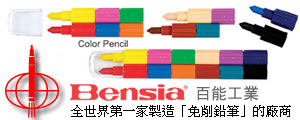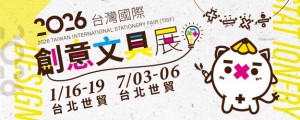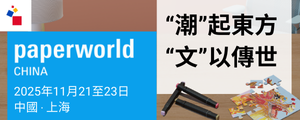Industry Achievement
Historic background
The Stationery Industry had a relatively late start in Taiwan. Before the end of World War II there was only one manufacturer, a producer of rough-made pencils. In the early stages of Post-War Taiwan, there was a great shortage of stationery articles and Taiwan almost completely relied upon imports. Therefore Taiwan’s stationery industry had its beginnings in the import business. Other large-scale manufacturers such as pens, pencils, crayons, carbon paper, stencil paper, watercolors, inks and printing inks gradually established since the 1950s. The output of Taiwan’s manufacturers partially displaced supplies from Japan, China and USA. Since the 1960s, Taiwan makers have consolidated their strength on both the domestic and export markets. In the past 30 years the entire industry greatly developed because of a protective 44% import tariff and a high NT dollar exchange rate. After reducing tariffs and increases in the value of the NT dollar, more and more foreign high quality products have entered Taiwan, creating sever competition for the local stationery industry.
There have also been two major challenges encountered by the Taiwan stationery industry. The first was the introduction of copy machines, and the second was the popularization of computers. The growing use of copying machines since the 1970s drove down demand for carbon paper and stencil paper. Later the popularization of PCs have greatly decreased the demand for pens and paper products. These continuously developing technologies have had a serious impact on some stationery articles and have resulted in the disappearance of many traditional concerns.
Moreover, since stationery is a labor-intensive industry, rising labor consciousness along with rising labor costs have weakened its competitive edge against competitors from China and South East Asia.
Status Quo
Sales revenue and added value of Taiwan’s stationery industry over the recent five years have seen little change in sales revenue and GDP.
Since the stationery industry is a relatively mature industry, the market is often influenced by a collection of trends such as macroeconomic development, national income and population growth. Along with the development of macroeconomy and increased national income, quality and fine design have become decisive reasons of purchasing, in addition to sheer need. Therefore the industry has tended to develop high value-added stationery items.
Japan used to be the major supplier of Taiwan’s stationery market. But due to the incessant increase of the Japanese Yen in recent years, import costs have also soared, and since local-made product quality has improved, imports from Japan have stagnated. However, Taiwan exports to the USA market have also decreased yearly due to intensive competition from China and the nations of South East Asia which can offer lower labor costs.
Fortunately, with the constant development of technology and mechanization, the employee ratio of this labor-intensive industry has lowered gradually.
The rising consciousness of environmental protection has also changed raw materials of stationery product manufacturing. For example, iqelite-made blotter covers have been replaced by resolvable plastic materials. Pencils have also enjoyed a new popularity because of their relative echo-friendly reputation.
Future Prospects
The stationery market is mostly influenced by macroeconomic development, national income and population growth. Since the macroeconomy is expected to keep on increasing national income, it is forecasted that the industry will enjoy healthy growth. And with local maker efforts to develop high-added-value production, the added value of stationery products will also keep growing. It is anticipated that sales revenue and added value of the industry will show a growth rate of about five to six percent. Detailed forecasts provided by the IBIS Database of the Taiwan Institute of Economic Research for the coming two years are listed below:
Forecasts of the sales revenue and added values of Taiwan’s stationery industry
Unit: million NT Dollar
| Year | Sales Revenue | Added Value | ||
| (NT$) | Growth Rate | (NT$) | Growth Rate | |
| 1998 | 18,812* | 5.70% | 11,692* | 6.16% |
| 1999 | 19,955* | 6.08% | 12,370* | 5.80% |
| 2000 | 21,098* | 5.73% | 13,047* | 5.47% |
| 2001 | 22,242* | 5.42% | 13,725* | 5.20% |
| 2002 | 23,385* | 5.14% | 14,403* | 4.94% |
*Source: IBIS Database, Taiwan Institute of Economic Research
In order to cope with the changes within the global industrial structure and market, Taiwan manufacturers have not only actively developed and improved products but have also upgraded to higher value-added levels of production. It is quite hopeful that Taiwan’s stationery industry will offer better added value.
The full-grown technology, especially the application and universality of computers, has made part of the stationery production absolete. To cope with this hi-tech impact, the industry must continue to adjust and innovate. It is expected that stationery items related to computer peripheral equipment will be a good way to maintain the industry.
Increasing import costs caused by the appreciation of the Japanese Yen and strengthened quality has let local made stationery items compete with Japan-made products on Taiwan’s import market. It is believed that imports from Japan will keep declining. In face of changes on the global stationery industrial structure, local makers have shifted labor-intensive and small-scale production of labor-intensive items such as paper clips and metal staples to China and SE Asian countries for their respective lower labor costs. They are now focusing on developing higher value-added items in Taiwan, such as staplers, file punches, pencil sharpeners, and large type pen-knives. Now Taiwan has become a competitor with Japan, which has always been a major export supplier of large-type stationery products. With local venders’ efforts on R&D, quality improvement, plus lower tariff duties on the import side, exports of Taiwan-made stationery products are promising in the long-term.
Since many advanced countries like Japan have fully-automated production lines for most stationery items, the local industry should also strive to catch up. At present the biggest problem for Taiwan’s stationery industry is technique transfer. If makers can successfully achieve technology transfer or develop new manufacturing technologies, they will be able to reduce labor costs and be much more efficient. Meanwhile, growing trends will cause problems for several small manufacturers since both the number of local venders and employees to be decreased in the future.
The stationery industry is also actively introducing the product bar-code system in order to obtain exact and updated data on production and marketing in order to avoid the problem of inventory surplus and shortages. In conclusion, this system of new approaches will greatly help to develop the entire industry.
TAIWAN ASSOCIATION OF STATIONERY INDUSTRIES
11F-8, 57, ChongQing S. Rd. Sec.1, Taipei, Taiwan 10045, R.O.C.
TEL: +886 2 23882611 FAX: +886 2 81926084
© Copyright 2007 TASI. All Rights Reserved.
Any comment or suggestion, please mail to webmaster@tasi.org
design by lionart







